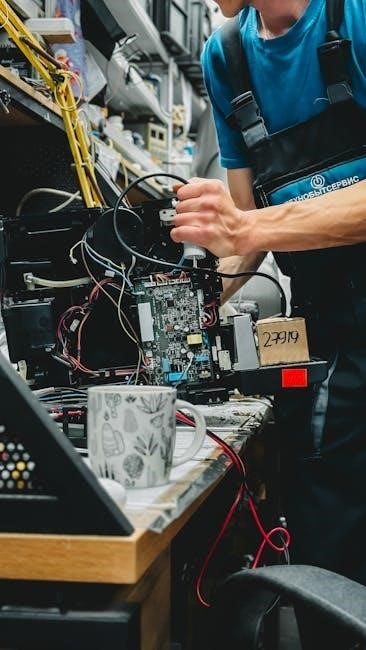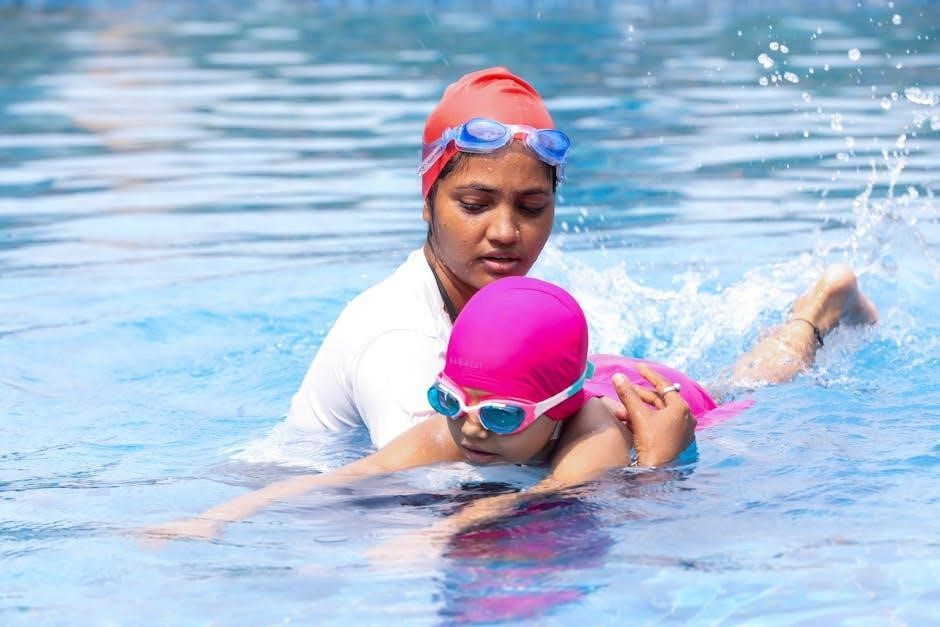
intex pool pump troubleshooting guide
Common Issues with Intex Pool Pumps
Intex pool pumps often face issues like failure to turn on‚ poor water circulation‚ strange noises‚ and filter-related problems. These issues can stem from electrical faults‚ clogged filters‚ or damaged hoses;
1.1. Pump Not Turning On
If your Intex pool pump isn’t turning on‚ start by checking the GFCI plug for tripping or damage. Ensure all electrical connections are secure and undamaged. Verify the power source is functioning properly. If issues persist‚ inspect the pump’s capacitor or internal wiring for faults. Consult a professional if the problem is complex or beyond DIY troubleshooting.
- Check the GFCI plug for tripping or damage.
- Ensure electrical connections are secure and undamaged.
- Verify the power source is functioning properly.
- Inspect the pump’s capacitor or internal wiring for faults.
- Consult a professional if the problem is complex or beyond DIY troubleshooting.
1.2. Poor Water Circulation
Poor water circulation in Intex pool pumps is often caused by kinked or blocked hoses‚ clogged filters‚ or improperly set valves. Ensure hoses are straight and free of debris. Clean or replace the filter cartridge if dirty‚ as this restricts water flow. Check valve settings to confirm they are open and properly aligned. If issues persist‚ inspect the pump basket for blockages and ensure it is securely sealed. Regular maintenance‚ such as cleaning the filter and inspecting hoses‚ can prevent circulation problems and keep your pool water clean and well-circulated.
1.3. Strange Noises from the Pump
Strange noises from an Intex pool pump‚ such as grinding‚ humming‚ or rattling‚ often indicate underlying issues. These sounds can result from debris blockages‚ air in the system‚ or worn-out internal components. To address this‚ turn off the pump and inspect for kinks or obstructions in the hoses. Ensure the pump basket is clean and free of debris. If the noise persists‚ check for proper electrical connections and consider resetting the GFCI plug. In severe cases‚ professional assistance may be required to repair or replace damaged parts‚ such as the motor or capacitor‚ to restore smooth operation.
1.4. Filter-Related Problems
Filter-related issues are common in Intex pool pumps‚ often causing poor water circulation or reduced pump efficiency. A clogged or dirty filter cartridge can restrict water flow‚ leading to system strain. Regular maintenance‚ such as cleaning or replacing the filter‚ is essential. Users should inspect the cartridge every 1-2 weeks‚ especially if the pool is heavily used. Cleaning can be done with a garden hose or specialized cleaners. If the filter is damaged or worn out‚ replacing it with the correct size and type is necessary. Proper filter care ensures optimal pump performance and maintains clean‚ safe pool water for swimmers.
Troubleshooting Steps for Intex Pool Pumps
Troubleshooting Intex pool pumps involves checking electrical connections‚ inspecting hoses for kinks or leaks‚ resetting the GFCI plug‚ and cleaning or replacing the filter cartridge.
2.1. Checking Electrical Connections
Ensure the pump is properly plugged into a GFCI-protected outlet. Verify all connections are tight and free from damage. If issues persist‚ check for tripped circuit breakers or blown fuses. Regularly inspect the cord for signs of wear or fraying‚ as this can prevent power supply. Make sure no extension cords are used‚ as they can cause voltage drops. If the pump still doesn’t start‚ consult the user manual or contact a professional. Proper electrical connections are crucial for safe and efficient operation of your Intex pool pump.
2.2. Inspecting Hoses for Kinks or Leaks
Regularly inspect pool hoses for kinks‚ twists‚ or visible damage. Kinked hoses restrict water flow‚ leading to poor circulation. Check for leaks at connections‚ as even small gaps can reduce pump efficiency. Tighten loose fittings and replace damaged or worn-out sections. Ensure hoses are securely attached to both the pump and pool inlet/outlet. Straighten kinked hoses or replace them if creases are permanent. Proper hose integrity ensures optimal water flow and prevents unnecessary strain on the pump motor. Addressing these issues early can prevent more serious problems like pump malfunction or reduced filtration effectiveness. Regular inspections help maintain smooth operation and extend the pump’s lifespan.

2.3. Resetting the GFCI Plug
Resetting the GFCI (Ground Fault Circuit Interrupter) plug is a common solution for Intex pool pump issues. Locate the GFCI plug‚ typically found on the pump or nearby. Press the “Reset” button firmly until it clicks‚ ensuring it is fully engaged. This resets the circuit and may resolve power issues. If the GFCI trips again‚ it could indicate a persistent electrical problem‚ such as moisture or a faulty connection. Regularly check and reset the GFCI as needed. If issues persist‚ consult a professional to address underlying electrical concerns. This simple step can often restore proper pump function and ensure safety.
2.4. Cleaning or Replacing the Filter Cartridge
Cleaning or replacing the filter cartridge is essential for maintaining your Intex pool pump’s efficiency. Start by turning off the pump and disconnecting the power. Remove the filter cartridge from the housing and rinse it thoroughly with a garden hose to eliminate dirt and debris. For deeper cleaning‚ soak the cartridge in a mixture of water and vinegar or a specialized cleaner. If the cartridge is damaged or excessively worn‚ replace it with a new one. Regular maintenance ensures optimal water circulation and filtration‚ preventing pump strain and prolonging its lifespan. Always refer to the manufacturer’s guidelines for specific instructions.

Maintenance Tips to Prevent Future Issues

Regularly clean the pump and filter to ensure optimal performance. Check hoses for kinks or leaks and monitor the pump’s operation to address issues early.
3.1. Regular Cleaning of the Pump and Filter
Regular cleaning is essential for maintaining your Intex pool pump’s efficiency. Start by turning off the pump and unplugging it for safety. Remove the filter cartridge and rinse it with a garden hose to eliminate dirt and debris. For tougher buildup‚ use a mixture of water and vinegar or a cartridge cleaner. Inspect the pump basket and remove any leaves or obstructions. After cleaning‚ reassemble all components and ensure they are securely connected. Consistent cleaning prevents clogs and ensures proper water circulation‚ keeping your pool clean and hygienic. This simple maintenance step can extend the pump’s lifespan significantly.
3.2. Ensuring Proper Hose Integrity
Ensuring proper hose integrity is crucial for optimal pump performance. Regularly inspect hoses for kinks‚ twists‚ or cracks‚ as these can restrict water flow. Clean hoses with a garden hose to remove dirt and debris. Secure all connections tightly to prevent leaks. Store hoses properly during off-seasons to avoid damage. If you notice persistent issues‚ consider replacing worn-out sections. Proper hose maintenance ensures smooth water circulation and prevents pump strain‚ extending the lifespan of your Intex pool pump. Regular inspections and timely repairs can help maintain efficient operation and prevent costly replacements.
3.3. Monitoring Pump Performance

Monitoring pump performance helps identify potential issues early. Check the pump’s flow rate and pressure regularly to ensure they’re within recommended levels. Listen for unusual noises‚ as they may indicate internal damage or blockages. Watch for signs of reduced water circulation‚ such as cloudy pool water or slow filtration. Keep an eye on the pump’s power consumption; sudden spikes could signal a problem. Perform routine visual inspections for leaks or wear. By closely monitoring your Intex pump’s operation‚ you can address minor issues before they escalate‚ ensuring efficient and reliable performance throughout the pool season. Regular checks are key to maintaining optimal function.

When to Call a Professional
Contact a professional for complex electrical issues or major pump damage. They handle repairs beyond DIY fixes‚ ensuring safety and proper functionality of your Intex pool system.

4.1. Complex Electrical Problems
Complex electrical issues with Intex pool pumps often require professional attention. Problems like faulty GFCI plugs‚ short circuits‚ or damaged wiring can be hazardous to address without expertise. Professionals can safely diagnose and repair these issues‚ ensuring compliance with safety standards like NEC 680.31 and 680.32‚ which mandate GFCI protection for pool equipment. Attempting such repairs without proper knowledge risks electrical shock or further damage. Always consult a certified technician for these situations to maintain safety and functionality of your pool system.
4.2. Major Pump Damage or Malfunction
Major pump damage or malfunction often necessitates professional intervention. If your Intex pool pump suffers from severe internal damage‚ cracked components‚ or complete failure to function‚ DIY repairs may not suffice. Signs include persistent leaks‚ excessive vibration‚ or the pump failing to prime despite proper setup. In such cases‚ a professional can assess whether the pump needs extensive repairs or replacement. They can also ensure that any replacements meet the pool’s specifications and safety standards. Attempting to fix major damage yourself could lead to further issues or safety hazards‚ making professional help the best course of action to restore your pool’s operation.